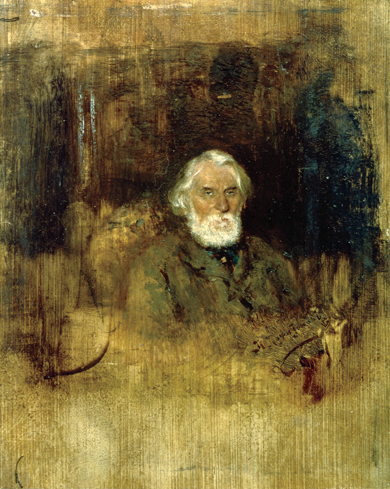Discussed in this essay:
The Europeans: Three Lives and the Making of a Cosmopolitan Culture, by Orlando Figes. Henry Holt and Co./Metropolitan Books. 592 pages. $37.50.
Sweet Days of Discipline, by Fleur Jaeggy. Translated by Tim Parks. New Directions. 112 pages. $13.95.
Poisoner in Chief: Sidney Gottlieb and the CIA Search for Mind Control, by Stephen Kinzer. Henry Holt and Co. 368 pages. $30.
“Not a great writer, though a pleasant one” was Vladimir Nabokov’s verdict on Ivan Turgenev, the first Russian novelist to make an impact abroad. Nabokov—who once complained about Henry James’s “vulgarities”—liked issuing high-handed, contrarian judgments. But he wasn’t alone in speaking of Turgenev with condescension. A Sportsman’s Sketches (1852), the book that made Turgenev’s name, was credited with helping to end serfdom in Russia, and Fathers and Sons (1862) introduced a lasting character type—the nihilist—in the person of Yevgeny Bazarov, who questions everything “with indescribable composure.” Fathers and Sons, however, made trouble for Turgenev. The Russian left interpreted it as a right-wing satire, while the right accused Turgenev of pandering to the left. In time, both sides agreed that he was a gutless centrist. Tolstoy and Dostoevsky belittled him, and their fame—which he promoted tirelessly in Paris—meant that later generations of Western readers had trouble reconciling his short, elegant books with preconceived notions of the turbulent Russian soul.

Portrait of Ivan Turgenev, by Ivan P. Pokhitonov © Tretyakov Gallery, Moscow/akg-images.
Turgenev’s personal life, too, lacked epic qualities. Bearded, broad-shouldered and six feet three inches tall, he looked the part, but had a weak, high-pitched voice and a gentle, diffident manner. His nationalist enemies spread the rumor that he lived in France and Germany out of contempt for his homeland. (Dostoevsky advised him to buy a telescope if he wanted to write convincingly about Russian affairs.) In truth, his place of residence was determined by that of Pauline Viardot, a famous mezzo-soprano, with whom he fell in love in 1843. Pauline’s husband, Louis, was twenty-one years older than she was. Louis didn’t concern himself with her emotional attachments so long as public proprieties were more or less observed. The result was a long-lasting affair in which the jealous-husband role fell largely to Turgenev, who had to put up with other admirers pursuing Pauline from time to time. “Sitting on the edge of someone else’s nest,” as Turgenev put it, became his settled position.
His friends were puzzled by his passivity, though one of them observed: “He needed the sort of person who would make him suffer, doubt, waver, be secretly jealous and dejected—one who, in a word, would torment him.” (Turgenev’s mother, it so happens, was remote and despotic even by the standards of early-nineteenth-century Russian landowners.) Still, the novelist’s doleful, nomadic existence, pitiable as it seemed to Tolstoy and others, makes him ideal for Orlando Figes’s purposes in The Europeans: Three Lives and the Making of a Cosmopolitan Culture (Henry Holt and Co./Metropolitan Books, $37.50). Figes uses the story of the Viardot-Turgenev household to anchor a massive study of nineteenth-century cosmopolitanism, and of the way social changes and technological advances—railways, steamships, the telegraph, photography—fostered a sense of pan-European identity. His central figures are an apt choice, because Pauline’s singing tours and Turgenev’s wanderings took them to every corner of the Continent. A list of the contemporary cultural notables whom they didn’t know might well be shorter than one of those they did.
The nineteenth century in Europe, historians usually argue, was the age of nationalism and the nation-state. “At the same time,” Figes writes, there was “a strong counter-current of internationalist sentiment.” Goethe, Marx, and the Saint-Simonians in France saw railways as a force for unification, as Figes recounts. But he’s more interested in practical developments in the high-cultural sphere. Improved transportation, for example, led to a stabilization of musical and theatrical repertoires by bringing in the bridge-and-tunnel crowd, which meant that shows could have longer runs. France dominated opera in the period in part because it operated a royalty system, and steamships put previously out-of-the-way places, such as the Swiss lakes and the Rhine region, on tourist itineraries—which were themselves in the process of being organized for the prosperous middle classes by figures like Thomas Cook. Then, as now, the big money in the arts came from image reproduction and music publishing rights. In short, the nineteenth century was “the first period of cultural globalization.”
Historians might quarrel with Figes’s relative neglect of politics, and of other kinds of globalization—colonialism, for instance. Other readers might wonder how some of his big-picture material connects with the group biography that structures the book, though Turgenev played a part in debates about copyright, Pauline Viardot was a skillful navigator of the changing music business, and Louis—an art critic, among other things—left his mark on the culture of gallery-going. Figes draws attention to Pauline’s achievements, but as you’d expect from a historian who’s best known for his work on Russia, his book’s presiding spirit is Turgenev’s.
It’s hard not to see a subtext here. Figes—who is British but took German citizenship in response to the Brexit referendum result—sees a lot to applaud in the Russian writer’s mild liberalism. “If you believe you’re a citizen of the world,” Britain’s then prime minister, Theresa May, said in 2016, “you’re a citizen of nowhere.” In Turgenev’s first novel, Rudin (1856), a Slavophile says much the same—“The cosmopolitan is . . . worse than a nonentity”—about the sensitive, tragically ineffectual hero.

Cyclamen at Christmas, by Ernst Ludwig Kirchner © Galerie Ludorff, Du?sseldorf, Germany/akg-images
“We came from all over the world,” the narrator of Sweet Days of Discipline (New Directions, $13.95), translated by Tim Parks from Fleur Jaeggy’s Italian, says of her fellow pupils at the Bausler Institut, a girls’ boarding school in the Appenzell in northeastern Switzerland. “There was a redhead, a Belgian, a Swedish blonde, the Italian girl, the girl from Boston.” The narrator’s roommate is a German girl with a snub nose and dimples who always combs her hair before going to bed. “I wanted to wring her neck,” the narrator remarks. There is also a black girl, small and pretty, whose father is “President of an African state.” She’s usually seen walking hand in hand with the headmistress, Frau Hofstetter, who doesn’t encourage her to mix with the other pupils, perhaps because “she was afraid we would eat the girl.” Later, the narrator watches from a distance as, sad and alone, the girl gathers flowers and then buries them. The sight elicits an inscrutable but striking metaphor: “She was the tiny dispatch rider of a routed army.”
The narrator—she refers to herself, when she has to, as “Miss X”—is meant to be “studying French, German and general culture. I wasn’t studying at all.” In her opening sentences, she notes that the Appenzell region is where the Swiss writer Robert Walser, who influenced Kafka, died in the snow on a walk he made from “the mental hospital in Herisau, not far from our college.” She doesn’t mention Walser’s writings, but his best-known novel, Jakob von Gunten (1909), is set in the Benjamenta Institute, a school where there’s only one textbook and the teachers are either sleeping or dead. (“One learns very little here,” Walser’s novel begins.) The Bausler Institut isn’t as strange as that—it appears to be a well-appointed repository for emotionally neglected daughters of the haute bourgeoisie—but there’s still a feeling that something, somewhere, is badly out of kilter. “Busy, fiery flowers” decorate the local windowsills. They suggest to the narrator that, behind the white-framed windows, “something serenely gloomy and a little sick is going on.”
Jaeggy—who was born in Switzerland in 1940 but made a career in Italy, where she got to know the intense Austrian writer Ingeborg Bachmann—doesn’t offer a diagnosis of the subtle spiritual malaise that seems to afflict the Bausler Institut. All the same, she lets a range of possibilities creep in. Miss X, who’s fourteen at the time she’s looking back on, has been immured in boarding schools since the age of eight and feels “lured into a state of stupor.” She is “in a wild hurry to be living in the world.” Her parents, whose infrequent letters she destroys, are separated. Her elderly father, a Herr Doktor who seems to have come down in the world, lives in sepulchral hotels. Her mother, who has remarried, supervises her education by means of notes mailed from Brazil. It’s the Fifties, and though she’s too young to remember it, the Second World War isn’t far in the background. In retrospect, she regrets her failure to ask her roommate, “Did you know Hitler?”
Obedience and discipline are the Bausler Institut’s watchwords, but “a boarding school is like a harem.” There are conversations about boys, and complex social conventions govern the younger girls’ crushes on the older ones. To fold someone’s pullovers is a kind of courtship: “We were fetishists,” the narrator writes. One day, a new girl, Frédérique, arrives. Frédérique is clever and hard to read and has an air of worldly sophistication. Miss X becomes obsessed with “conquering” her. In due course, the two of them become inseparable. Nothing sexual happens—“with us there was a kind of fanaticism that prevented any physical expression”—but it’s evident, at least on the narrator’s side, that love is part of the picture. Then, for reasons that aren’t clear to her, Miss X throws over Frédérique for an outgoing Belgian named Micheline, who speaks constantly of parties and of her youthful, indulgent father. Frédérique offers no reproach; her father dies; she leaves the school, listening impassively as Miss X declares her love. A coda to the story details Frédérique’s fate.
Jaeggy handles this plot with a fine contempt for both sentiment and conventional modes of dramatization. The announcement that Frédérique is leaving, and the characters’ farewell at the railway station, takes up little more than a page. Even so, the torpid world of the Bausler Institut, where for the older girls “a sort of senile childhood was protracted almost to insanity,” comes to life in Miss X’s compact monologue. The sentences are short, epigrammatic (“The locker, dear little mortuary of our thoughts”), and filled with deadpan humor as well as something more wild and brooding. Miss X breathes the same air as the narrators of Samuel Beckett and Thomas Bernhard, but her manner, which somehow doesn’t seem mannered, is all her own. Muriel Spark’s more astringent, nouveau roman–style performances may be another starting place for comparisons—or maybe Ottessa Moshfegh’s delicious cruelties. Either way, Turgenev, in another life, might have found much to admire here.
Sidney Gottlieb visited a good many countries in the course of a career in service to the U.S. government. He spoke “good German and fair French,” and—unusual for the bureaucratic circles in which he moved—wasn’t a WASP but a son of Hungarian Jewish immigrants, born in the Bronx in 1918. Munich was his home for two years in the Fifties, and he was a regular visitor to Japan, working in both places with colleagues whose wartime backgrounds would have unsettled a less broad-minded person. He also traveled to the Republic of the Congo and gave considerable thought to Cuba. After his retirement in 1973, he and his wife got on a ship to Australia and made their way from there to Uttar Pradesh, where they volunteered at a leper hospital. Not many Americans of Gottlieb’s generation were such global citizens—though that’s not exactly the way Stephen Kinzer portrays him in Poisoner in Chief: Sidney Gottlieb and the CIA Search for Mind Control (Henry Holt and Co., $30).

Study for Three Kids Before a Fence, by Parmigianino © Musée Condé, Chantilly, France/Bridgeman Images
Gottlieb first came to public attention in 1975. William Colby, then the CIA’s director, didn’t follow the script in his testimony to the Rockefeller Commission, a toothless body set up by the Ford Administration to address, and preferably quash, post-Watergate suspicions that the agency was not wholly on the up-and-up. Colby’s frankness about unhinged secret programs, which led to his removal from office later that year, triggered a cascade of headlines. These revelations stirred up, in turn, the surviving family of a CIA scientist, Frank Olson, who had killed himself in 1953—the outcome, it now turned out, of a breakdown he’d had after drinking a glass of Cointreau that Gottlieb’s deputy had spiked with LSD. By the end of the Seventies, the researcher John Marks had pieced together a broad outline of Gottlieb’s activities, and the MKUltra program passed into pop-cultural legend. Gottlieb, who died in 1999, spent the rest of his life evading lawyers and reporters while raising goats at a remote eco-home in Virginia.
The CIA spent the Fifties and early Sixties working out that brainwashing isn’t feasible. “But it is intriguing,” one front man observed. “It is a lot of fun.” Gottlieb, who’d started out as an agricultural chemist by writing a thesis on cowpeas, joined the agency in 1951. The security services’ long-running search for a truth drug converged with worries about Communist mind control to give him the idea of looking into LSD. He took some, filed a report on the shimmering sausage skin that had subsequently seemed to envelop his body, and got his bosses’ backing for further experiments. Gottlieb did acid “at least two hundred times,” and encouraged his co-workers to try it too. Less amusingly, he and his team administered it to “special interrogation” victims at bases abroad, and oversaw similarly brutal research projects by civilian psychiatrists. CIA-funded drug trials opened the doors of perception for Fifties college students like Allen Ginsberg, but the experience was somewhat different for psychiatric patients and addiction-clinic inmates, especially when combined with electroshock therapy and sensory deprivation.
Kinzer’s trashily written but absorbing book combines moral outrage about these episodes with moments of pure comedy. To the question of how the national security apparatus came to think it important to find out how LSD affected elephants and Siamese fighting fish, the book offers various answers: institutional paranoia, scientific curiosity, and, finally, bureaucratic inertia. The Fifties brainwashing panic was a response to Stalin’s show trials, ideological coercion in Mao’s China, and, above all, defecting American soldiers in Korea. Communist interrogators, the reasoning went, plainly had access to futuristic techniques. How else could they have gotten American P.O.W.s to see their self-evidently wrong point of view? Entranced by this fun-house-mirror reflection of the Marxist theory of false consciousness, the CIA set out to reverse-engineer the enemy’s presumed breakthroughs. In the meantime, the enemy continued to rely on isolation, beatings, and old-fashioned persuasion, and the Soviet Union couldn’t even identify the toxin—laboriously extracted by Gottlieb’s men from Alaskan butter clams—in the U-2 pilot Francis Gary Powers’s suicide kit.
Throughout, Gottlieb himself remains a cipher: “a scientist who ate yogurt.” In the Fifties, he milked his goats and munched carrots while everyone else was knocking back highballs, and in the Sixties—when he gave up on mind control, and became the CIA’s equivalent of Q in the James Bond movies—he was a thoughtful boss who remembered birthdays and spouses’ names. Seeing the way the wind was blowing after Watergate, he had the MKUltra files shredded, and later defended himself, with success, from a Senate committee’s inquiries. But there seems to have been some sort of quest for personal redemption. For years as, in effect, an old hippie, he worked as a speech therapist in a school and helped out at a hospice. His time at the leper hospital, too, doesn’t suggest an easy conscience. Kinzer ends his book with a surprisingly measured judgment of the former “psychedelic Mengele,” who was summed up, years before, by one of his more hard-boiled associates: “Sidney was a nice guy. He was a fuckin’ nut. They were all nuts.”





































































































